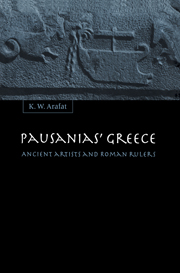Book contents
- Frontmatter
- Contents
- Map of Roman Greece
- Preface and acknowledgements
- List of abbreviations
- Chapter 1 Introduction
- Chapter 2 Pausanias on the past
- Chapter 3 Pausanias on the rulers of Roman Greece 1: introduction, Mummius and Sulla
- Chapter 4 Pausanias on the rulers of Roman Greece 2: Caesar and Augustus
- Chapter 5 Pausanias on the rulers of Roman Greece 3: Nero to Marcus Aurelius
- Chapter 6 Pausanias on Herodes Atticus and other benefactors
- Chapter 7 Conclusions
- Bibliography
- Index of Pausanias passages cited
- Index of other authors and passages cited
- General index
Chapter 6 - Pausanias on Herodes Atticus and other benefactors
Published online by Cambridge University Press: 22 September 2009
- Frontmatter
- Contents
- Map of Roman Greece
- Preface and acknowledgements
- List of abbreviations
- Chapter 1 Introduction
- Chapter 2 Pausanias on the past
- Chapter 3 Pausanias on the rulers of Roman Greece 1: introduction, Mummius and Sulla
- Chapter 4 Pausanias on the rulers of Roman Greece 2: Caesar and Augustus
- Chapter 5 Pausanias on the rulers of Roman Greece 3: Nero to Marcus Aurelius
- Chapter 6 Pausanias on Herodes Atticus and other benefactors
- Chapter 7 Conclusions
- Bibliography
- Index of Pausanias passages cited
- Index of other authors and passages cited
- General index
Summary
In this chapter I consider the benefactors, or euergetai, whom Pausanias mentions, other than the emperors. They comprise the Augustan and the Hadrianic Eurykles of Sparta; Philopappos of Commagene, whose monument in Athens was erected in c.114–6; ‘Aithidas’ of Messene (mid second century ad); ‘the Roman senator Antoninus’ (a contemporary of Pausanias, whose floruit was in the 160s); and Herodes Atticus (c.ad 103–79). The length of this chapter reflects the markedly small number of such benefactors, and the proportion of it devoted to Herodes Atticus also reflects Pausanias' own attentions. Both of these aspects are worth examination.
Herodes Atticus was a contemporary of Pausanias and a man whose activities in Greece – well attested by Pausanias – are unique in their scope for a private individual in this period. These activities (and those of Herodes elsewhere) reveal a man who acted in many respects in the manner of an emperor, and shed an informative light on the practice of private benefaction in Pausanias' day. It is the sheer scale of Herodes' capacity to act as a benefactor that makes him so exceptional, allowing him, for example, to create his own private projects such as his estates at Marathon and Loukou, as well as the more conspicuous public monuments.
The primary purpose of such benefactions is publicity for the benefactor: one acts thus in order to be noticed. Hence being mentioned by writers such as Pausanias was part of the purpose of these benefactions, part of the pay-off.
- Type
- Chapter
- Information
- Pausanias' GreeceAncient Artists and Roman Rulers, pp. 191 - 201Publisher: Cambridge University PressPrint publication year: 1996

